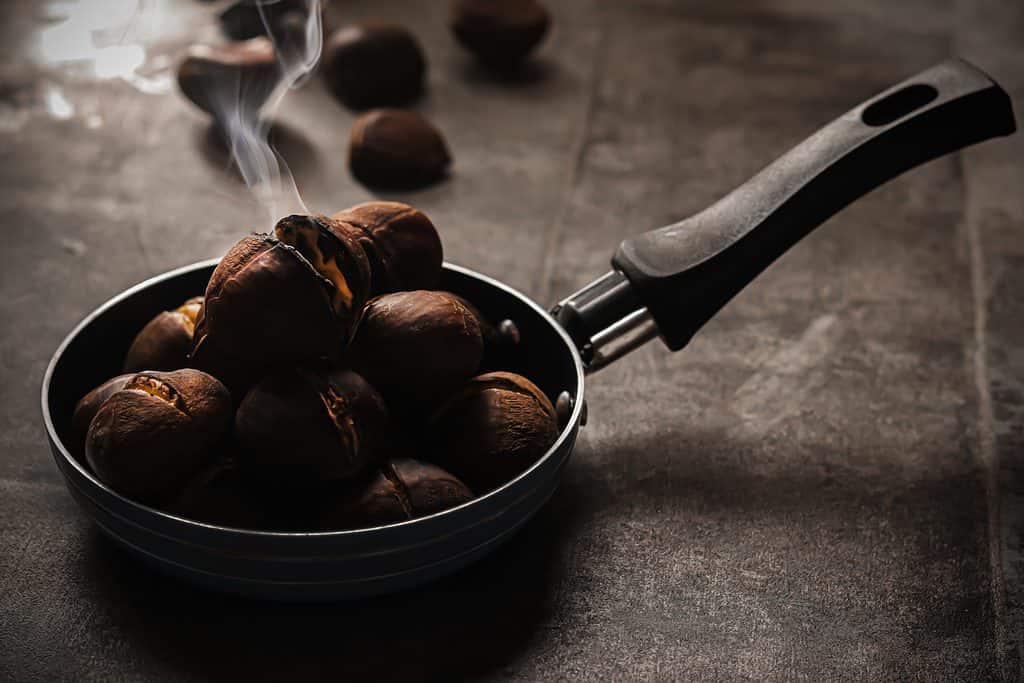Many nuts are unsafe for dogs — even when they’re not toxic, they can pose a choking hazard! But can dogs eat chestnuts?
Chestnuts can be safe for dogs, but only when served properly. Avoid chestnuts that are seasoned, salted, or coated with chocolate or sugar. Horse chestnuts are toxic and should never be fed to dogs. All chestnuts are toxic when raw, so be sure to cook them first!
In this article, we’ll discuss which types of chestnuts dogs can eat, the benefits and risks to feeding your dog chestnuts, and more.
Are Chestnuts Safe for Dogs?

©Belal Asaad20/Shutterstock.com
Chestnuts aren’t entirely safe for dogs. Firstly, they can pose a choking hazard, especially for small dogs. Next, some types of chestnut are toxic to dogs—and some store-bought chestnuts will contain other toxic ingredients.
The safe types of chestnut are: American, sweet, and water chestnuts. They must be unsalted, unseasoned, and contain no sugar. Never feed your dog chocolate-covered chestnuts.
It’s also vital to cook the chestnuts before feeding them to your dog. Raw chestnuts contain tannins, which are toxic to dogs. They’re also easier for dogs to choke on.
Horse chestnuts are toxic to dogs, so avoid feeding these. It should be pretty easy, since they’re also toxic to humans—so I sure hope you aren’t eating them either!
Benefits of Cooked Chestnuts for Dogs
Plain, cooked chestnuts are good for dogs when fed in moderation. Here are their benefits:
- High amounts of antioxidants to aid in cell health.
- Omega 3 and 6 fatty acids to promote healthy skin and coat.
- Fiber helps to regulate your dog’s digestive system and promote regular bowel movements.
- High potassium to help fluid remain balanced in a dog’s cells.
- Vitamin C promotes a healthy immune system.
Risks of Chestnuts for Dogs
- They can pose a choking hazard, particularly when uncooked.
- Raw chestnuts contain tannins, which are toxic to dogs.
- Seasoned chestnuts often contain garlic or onion powder, which are both toxic.
- Chocolate-covered chestnuts are toxic to dogs.
- Chestnuts with high salt content can cause salt poisoning if fed in large quantities.
- Chestnuts containing sugar are unhealthy for dogs, especially when fed in large amounts.
- They’re high in fat and can cause pancreatitis if fed in large amounts.
How to Feed Your Dog Chestnuts
- Roast the chestnuts in the oven without any seasonings or sugars.
- Remove the shells.
- Rinse the chestnut under water and remove hard pieces to prevent choking hazards.
- Feed a small amount to your dog to start.
Chestnuts shouldn’t be a regular treat for your dog, only something fed very occasionally. Always speak to your veterinarian before incorporating new foods into your dog’s regular diet.
What Happens if a Dog Eats Raw Chestnuts?
If your dog eats raw chestnuts, or chestnuts containing toxic ingredients like garlic powder, onion powder, or chocolate, contact an emergency veterinarian or a pet poison hotline.
If they eat a large amount of chestnuts containing a lot of salt, you might also want to call to ensure they haven’t given themselves salt poisoning.
Do not attempt to make them vomit—this can be dangerous, especially with hard objects like nuts.
You also shouldn’t wait for an appointment with your regular veterinarian. While this is usually cheaper than an emergency vet, poisoning is an emergent situation. It’s possible that your dog will become sicker or even die without immediate intervention, so it’s best to at least have a professional assess the situation first.
Symptoms of poisoning such as organ damage can’t be monitored or seen at home, so don’t wait until problems occur if your dog has eaten something they shouldn’t have.
How Many Chestnuts Can a Dog Eat?
While dogs can eat chestnuts, they should only eat them in moderation. One to two chestnuts as an occasional treat are plenty, and it’s important to consider the size of your dog as well. Toy breeds might do better with just half a chestnut, while giant breeds can have a couple.
Too many chestnuts can cause stomach issues, including pancreatitis—which can occur if a dog eats too many fatty foods.
Pancreatitis is when the pancreas inflames, causing symptoms like lethargy, abdominal pain, vomiting, diarrhea, increased thirst, and decreased appetite.
If you notice signs of pancreatitis after your dog consumes a large amount of chestnuts, or other fatty foods, contact an emergency veterinarian for help. Pancreatitis can be life-threatening, especially if left untreated.
Can Dogs Eat Baked Goods Containing Chestnuts?
Technically, your dog can eat small amounts of baked goods containing chestnuts so long as they don’t contain toxic ingredients. However, I would suggest avoiding them.
Many baked goods do contain unsafe seasonings. They’re also likely to contain salts and sugars that aren’t healthy for your pup.
If you want to feed your dog a tasty desert, I recommend baking them some homemade treats instead of giving them human foods.
For similar fall vibes, look for treats that contain pumpkin or sweet potato!
Up Next…
- 5 Nuts Your Dogs Can Eat Safely, and 4 To Avoid
- Can Dogs Eat Peanuts Safely? What Are the Risks?
- Can Dogs Eat Cashews Safely? What You Should Know
The post Can Dogs Eat Chestnuts? appeared first on AZ Animals.
from Animal News, Facts, Rankings, and More! - AZ Animals https://ift.tt/TMPqdKR